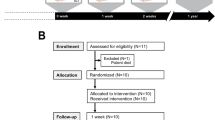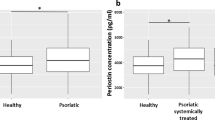Abstract
Skin-derived antileukoproteinase (SKALP), also known as elafin, is a proteinase inhibitor with specificity for polymorphonuclear leucocyte (PMN)-derived elastase and proteinase-3. SKALP is absent in normal human epidermis, but is strongly induced in inflammatory dermatoses such as psoriasis. SKALP is putatively involved in the regulation of cutaneous inflammation by inhibiting PMN derived proteinases. The aim of this study was to investigate SKALP expression and PMN infiltration during wound healing in human skin. This was examined in healing excisional wounds in normal skin and in impaired healing in various types of chronic venous ulcers. Tissues were analysed using immunohistochemistry and Northern blot analysis. Healing of excisional wounds was studied from day 0 to day 14. An influx of PMN was seen rapidly after wounding and was maximal between day 2 and 4 and then subsided. SKALP was induced within 48 h and was expressed in the suprabasal keratinocytes of the wound edge and the migrating epidermal sheet. SKALP expression was maximal on day 4 and was downregulated at the time of complete reepithelialization (7–14 days). In venous ulcers, PMN were abundant in the wound bed and scarce under the wound edge. SKALP was strongly expressed in the keratinocytes of the wound edge in all types of ulcers studied. In the wound bed, SKALP was not detectable. Our results suggest that SKALP plays a role in the acute, inflammatory phase of wound healing. From the kinetics and topology of SKALP expression we surmise that it negatively regulates PMN infiltration.
Similar content being viewed by others
References
Alkemade H, Kerkhof P van de, Schalkqijk J (1992) Demonstration of skin-derived antileukoproteinase (SKALP) in urine of psoriatic patients. J Invest Dermatol 99:3–7
Alkemade HA, Molhuizen HO, Vlijmen Willems IM van, Haelst UJ van, Schalkwijk J (1993) Differential expression of SKALP/elafin in human epidermal tumors. Am J Pathol 143: 1679–1687
Alkemade JAC, Molhuizen HOF, Ponec M, Kempenaar JA, Zeeuwen PLJM, Jongh GJ de, Vlijmen-Willems MJJ van, Erp PEJ van, Kerkhof PCM van de, Schalkwijk J (1994) SKALP/elafin is an inducible proteinase inhibitor in human epidermal keratinocytes. J Cell Sci 107:2335–2342
Alkemade JAC, Jongh GJ de, Arnold WP, Kerkhof PCM van de, Schalkwijk J (1995) Levels of skin-derived antileukoproteinase (SKALP)/elafin in serum correlate with disease activity during treatment of severe psoriasis with cyclosporin A. J Invest Dermatol 104:189–193
Chang A, Schalkwijk J, Happle R, Kerkhof PC van de (1990) Elastase-inhibiting activity in scaling skin disorders. Acta Derm Venereol (Stockh) 70:147–151
Reference deleted
Clark RAF (1993) Mechanisms of cutaneous wound repair. In: Westerhof W (ed) Leg ulcers: diagnosis and treatment. Elsevier Science, Amsterdam, pp 29–50
Clark RA, Winn HJ, Dvorak HF, Colvin RB (1983) Fibronectin beneath reepithelializing epidermis in vivo: sources and significance. J Invest Dermatol [Suppl] 80:26s-30s
Grinnell F, Zhu M (1994) Identification of neutrophil elastase as the proteinase in burn wound fluid responsible for degradation of fibronectin. J Invest Dermatol 103:155–161
Grinnell F, Ho CH, Wysocki A (1992) Degradation of fibronectin and vitronectin in chronic wound fluid: analysis by cell blotting, immunoblotting, and cell adhesion assays. J Invest Dermatol 98:410–416
Molhuizen HO, Alkemade HA, Zeeuwen PL, Jongh GJ de, Wieringa B, Schalkwijk J (1993) SKALP/elafin: an elastase inhibitor from cultured human keratinocytes. Purification, cDNA sequence, and evidence for transglutaminase cross-linking. J Biol Chem, 268:12028–12032
Molhuizen HO, Zeeuwen PL, Olde Weghuis D, Geurts van Kessel A, Schalkwijk J (1994) Assignment of the human gene encoding the epidermal serine proteinase inhibitor SKALP (PI3) to chromosome region 20q12→q13. Cytogenet Cell Genet 66:129–131
Newman SL, Henson JE, Henson PM (1982) Phagocytosis of senescent neutrophils by human monocyte derived macrophages and rabbit inflammatory macrophages. J Exp Med 156: 430–442
Saheki T, Ito F, Hagiwara H, Saito Y, Kuroki J, Tachibana S, Hirose S (1992) Primary structure of the human elafin precursor preproelafin deduced from the nucleotide sequence of its gene and the presence of unique repetitive sequences in the prosegment. Biochem Biophys Res Commun 185:240–245
Sallenave JM, Ryle AP (1991) Purification and characterization of elastase-specific inhibitor. Sequence homology with mucus proteinase inhibitor. Biol Chem Hoppe Seyler 372:13–21
Sallenave J, Schullmann J, Crosley J, Jordana M, Gauldie J (1995) Regulation of secretory leukocyte proteinase inhibitor (SLPI) and elastase-specific inhibitor (ESI/elafin) in human airway epithelial cells by cytokines and neutrophilic enzymes. Am J Resp Cell Mol biol 11:733–741
Reference deleted
Schalkwijk J, Chang A, Janssen P, Jongh GJ de, Mier PD (1990) Skin-derived antileucoproteases (SKALPs): characterization of two new elastase inhibitors from psoriatic epidermis. Br J Dermatol 122:631–641
Schalkwijk J, Roo C de, Jongh GJ de (1991) Skin-derived antileukoproteinase (SKALP), an elastase inhibitor from human keratinocytes. Purification and biochemical properties. Biochim Biophys Acta 1096:148–154
Schalkwijk J, Vlijmen IM van, Alkemade JA, Jongh GJ de (1993) Immunohistochemical localization of SKALP/elafin in psoriatic epidermis. J Invest Dermatol 100:390–393
Tonnesen MG, Worthen GS, Johnston RB (1988) Neutrophil emigration, activation, and tissue damage. In: Clark RAF, Henson PM (eds) Molecular and cellular biology of wound repair. Plenum Press, New York, pp 149–183
Weiss SJ (1989) Tissue destruction by neutrophils. N Engl J Med 320:365–376
Wiedow O, Schroder JM, Gregory H, Young JA, Christophers E (1990) Elafin: an elastase-specific inhibitor of human skin. Purification, characterization, and complete amino acid sequence. J Biol Chem 265:14791–14795
Wiedow O, Lüdemann J, Utecht B (1991) Elafin is a potent inhibitor of proteinase 3. Biochem Biophys Res Commun 174: 6–10
Author information
Authors and Affiliations
Additional information
Some of the results reported here were presented at the meeting of the European Society for Dermatological Research in Vienna, September 1994.
Rights and permissions
About this article
Cite this article
van Bergen, B.H., Andriessen, M.P.M., Spruijt, K.I.J. et al. Expression of SKALP/elafin during wound healing in human skin. Arch Dermatol Res 288, 458–462 (1996). https://doi.org/10.1007/BF02505235
Received:
Issue Date:
DOI: https://doi.org/10.1007/BF02505235




